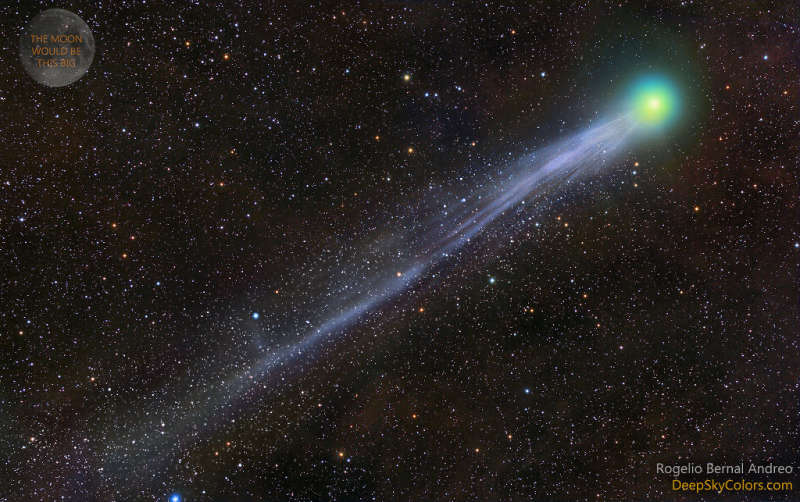
|
Credit & Copyright: Rogelio Bernal
Andreo (Deep Sky Colors)
Explanation:
Sweeping north
in planet Earth's sky, Comet Lovejoy's greenish coma
and blue tinted ion tail stretched across this
field of stars in
the constellation Taurus on January 13.
The inset at the upper left shows the 1/2 degree angular size of
the full moon for scale.
So Lovejoy's coma appears only a little smaller (but much fainter)
than a full moon on the sky, and its tail is visible
for over 4 degrees across the frame.
That corresponds to over 5 million kilometers
at the comet's estimated distance of 75 million kilometers
from Earth.
Blown by the solar wind, the comet's tenuous, structured
ion tail streams
away from the Sun, growing as
this Comet Lovejoy
heads toward perihelion, its closest approach to the Sun, on January 30.
While diatomic carbon
(C2) gas fluorescing in sunlight
produces the coma's green color, the fainter bluish tail is tinted by
emission from ionized carbon monoxide (CO+).
|
January February March April May June July August September October November December |
| ||||||||||||||||||||||||||||||||||||||||||||||||
NASA Web Site Statements, Warnings, and Disclaimers
NASA Official: Jay Norris. Specific rights apply.
A service of: LHEA at NASA / GSFC
& Michigan Tech. U.
Based on Astronomy Picture
Of the Day
Publications with keywords: comet - comet tail
Publications with words: comet - comet tail
See also:
- APOD: 2024 December 16 Á A Kilometer High Cliff on Comet Churyumov Gerasimenko
- APOD: 2024 November 27 Á The Meteor and the Comet
- APOD: 2024 November 11 Á The Unusual Tails of Comet Tsuchinshan Atlas
- APOD: 2024 November 6 Á Comet Tsuchinshan Atlas over the Dolomites
- APOD: 2024 October 21 Á Comet Tsuchinshan ATLAS over California
- Comet Tsuchinshan ATLAS Flys Away
- Most of Comet Tsuchinshan ATLAS
